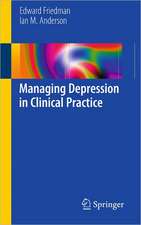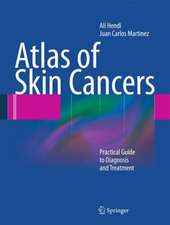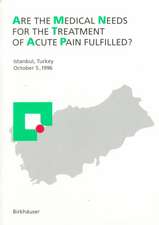Acupuncture: Textbook and Atlas
Autor Gabriel Stux Ilustrat de Petra Kofen Traducere de Karl A. Sahm Autor Bruce Pomeranzen Limba Engleză Paperback – 18 noi 2011
Following an introduction to the philosophical and theoreti- cal background of traditional Chinese medicine, the dia- gnostic system is presented: the Chinese system of channels and functional organs, the significance of pointsand point categories, methods of needling and moxibustion. There is a chapter on treatment based on western diagnosis.
Preț: 541.54 lei
Preț vechi: 637.10 lei
-15% Nou
103.64€ • 107.80$ • 85.56£
Carte tipărită la comandă
Livrare economică 14-28 aprilie
Specificații
ISBN-10: 3642717446
Pagini: 360
Ilustrații: XII, 342 p.
Dimensiuni: 210 x 280 x 19 mm
Greutate: 0.81 kg
Ediția:Softcover reprint of the original 1st ed. 1987
Editura: Springer Berlin, Heidelberg
Colecția Springer
Locul publicării:Berlin, Heidelberg, Germany
Public țintă
ResearchCuprins
1 Scientific Basis of Acupuncture.- 1.1 Acupuncture Analgesia (Basis Research).- 1.2 Acupuncture Analgesia for Chronic Pain.- 1.3 Drug Addiction.- 1.4 Asthma, Nerve Regeneration and Cardiovascular Effects of Acupuncture.- 1.5 Acupuncture Points (Do They Really Exist?).- 2 History of Acupuncture.- 3 Background and Theory of Traditional Chinese Medicine.- 3.1 Tao, Yin and Yang.- 3.2 The Cosmic Vital Energy: Qi.- 3.3 Jing, the Life Essence.- 3.4 Shen, or Psychic Energy.- 3.5 Disturbances of Qi.- 3.6 The System of Five Phases.- 3.7 External Climatic Factors.- 3.7.1 Description of the Climatic Factors.- 3.8 Internal Emotional Factors.- 4 Diagnosis in Traditional Chinese Medicine.- 4.1 Eight Diagnostic Criteria, Ba gang.- 4.2 Interior and Exterior Li, Biao.- 4.3 Excess and Deficiency Shi, Xu.- 4.4 Heat and Cold Re, Han.- 4.5 Yin and Yang.- 4.6 Four Examinations Si zh?n.- 4.7 Visual Observation Wàng zh?n.- 4.8 Listening and Smelling Wén zh?n.- 4.9 Questioning Wèn zh?n.- 4.10 Physical Examination Qie zh?n.- 5 Chinese System of Channels, Organs and Points.- 5.1 Channels and Organs.- 5.2 Presentation of the Point Categories.- 5.2.1 Shu Points or Transport Points.- 5.2.2 Mu or Alarm Points.- 5.2.3 Influential Points, Hui Xue.- 5.2.4 Xi-Cleft Points.- 5.2.5 Five Shu Points.- 5.2.6 Tonification Point.- 5.2.7 Sedative Point.- 5.2.8 Jing Well Point.- 5.2.9 Ying Point.- 5.2.10 Yuan Source Point.- 5.2.11 Jing Point.- 5.2.12 He Sea Point.- 5.2.13 Luo Connecting Point.- 5.2.14 Confluent Points.- 5.3. Methods of Point Location.- 5.3.1 Anatomical Landmarks.- 5.3.2 Proportional Cun Measurement.- 5.3.3 Proportional Measurement.- 5.3.4 Location by Means of Specific Posture.- 5.3.5 Location by Measurement of Skin Resistance.- 5.3.6 Location with the Aid of Other Points.- 5.3.7 Combination of Different Methods.- 5.3.8 Location of Painful, Sensitive or Tender Points.- 6 Systematic Description of Channels and Points.- 6.1 Lung Channel.- 6.2 Large Intestine Channel.- 6.3 Stomach Channel.- 6.4 Spleen Channel.- 6.5 HeartChannel.- 6.6 Small Intestine Channel.- 6.7 Urinary Bladder Channel.- 6.8 Kidney Channel.- 6.9 Pericardium Channel.- 6.10 Sanjiao Channel.- 6.11 Gallbladder Channel.- 6.12 LiverChannel.- 6.13 Du Mai.- 6.14 Ren Mai.- 6.15 Chong Mai.- 6.16 Dai Mai.- 6.17 Yangqiao.- 6.18 Yinqiao.- 6.19 Yangwei.- 6.20 Yinwei.- 6.21 Extra Points.- 7 Regions with Important Acupuncture Points.- 7.1 Face.- 7.1.1 Points Around the Orbita.- 7.1.2 Points Around the Ear.- 7.1.3 Points Around the Nose.- 7.2 NeckArea.- 7.3 Dorsal Side of the Trunk.- 7.4 Abdominal Area.- 7.4.1 Epigastrium.- 7.4.2 Middle and Lower Parts of the Abdominal Area.- 7.5 Shoulder Area.- 7.6 Points Around the Knee Joint.- 8 Technique of Acupuncture.- 8.1 Acupuncture Needles.- 8.2 Technique of Insertion and Stimulation of the Needles.- 8.3 De Qi Sensation.- 8.4 Tonifying and Sedating Methods of Stimulation.- 8.5 Electroacupuncture, Electrostimulation.- 8.6 Sterilization of the Needles.- 8.7 Complications of Acupuncture Treatment.- 9 Moxibustion.- 9.1 Indications and Methods.- 9.2 Direct Moxibustion.- 9.3 Indirect Moxibustion with Ginger Slice Isolation.- 9.4 Moxibustion with “Moxa Cigars”.- 9.5 Moxibustion by Heating Acupuncture Needles.- 9.6 Infrared Moxibustion.- 10 Laser Acupuncture.- 11 Acupressure.- 12 Ear Acupuncture.- 12.1 Technique of Ear Acupuncture.- 12.2. Representation of the Body on the Auricle.- 12.3 Numbering of Ear Points.- 12.4 Rules for Selection of Ear Points.- 13 Scalp Acupuncture.- 13.1 Fourteen Lines for Treatment.- 13.2 Method of Needling.- 14 Hand Acupuncture.- 14.1 Points of the Dorsum of the Hand.- 14.2 Points on the Palm.- 15 Acupuncture Treatment.- 15.1 Principles of Acupuncture and Major Rules of Point Selection.- 15.2 Locomotor Disorders.- 15.2.1 Arthrosis of the Jaw Joint.- 15.2.2 Cervical Spondylitis, Torticollis, Rheumatoid Arthritis.- 15.2.3 Intercostal Neuralgia, Trauma of the Thorax, Ankylosing Spondylitis, Zoster Neuralgia.- 15.2.4 Sciatica, Lumbar Pain.- 15.2.5 Periarthritis Humeroscapularis, Frozen Shoulder.- 15.2.6 Epicondylitis, Tennis Elbow.- 15.2.7 Pain in the Wrist Joint.- 15.2.8 Pain in the Hand, Rheumatoid Arthritis, Dupuytren’s Contraction.- 15.2.9 Coxarthrosis, Coxarthritis.- 15.2.10 Gonarthrosis, Pain in the Knee Joint.- 15.2.11 Pain in the Ankle Joint.- 15.2.12 Painin the Toes.- 15.2.13 Rheumatoid Arthritis.- 15.3 Respiratory Disorders.- 15.3.1 CommonCold.- 15.3.2 Tonsillitis, Laryngitis.- 15.3.3 Maxillary Sinusitis.- 15.3.4 Frontal Sinusitis.- 15.3.5 Chronic Bronchitis.- 15.3.6 Bronchial Asthma.- 15.4 Cardiovascular Disorders.- 15.4.1 Coronary Heart Disease with Angina Pectoris.- 15.4.2 Cardiac Neurosis.- 15.4.3 Cardiac Arrhythmia.- 15.4.4 Exhaustion Conditions in Heart Disease.- 15.4.5 Hypertension.- 15.4.6 Hypotension.- 15.4.7 Disturbances of Peripheral Blood Supply.- 15.5 Gastroenterological Disorders.- 15.5.1 Esophagitis, Dysphagia.- 15.5.2 Gastritis, Gastroenteritis.- 15.5.3 Gastric and Duodenal Ulcer.- 15.5.4 Diarrhea.- 15.5.5 Irritable Bowel Disease.- 15.5.6 Constipation.- 15.5.7 Hemorrhoids, Anal Fissure.- 15.5.8 Cholangitis, Cholecystitis, Biliary Dyskinesia, Biliary Colic.- 15.5.9 Hepatitis.- 15.6 Mental Disturbances and Illnesses.- 15.6.1 Depression.- 15.6.2 Exhaustion Conditions.- 15.6.3 Agitation.- 15.6.4 Sleep Disturbances.- 15.6.5 Schizophrenia.- 15.6.6 Drug Addiction.- 15.6.7 Alcohol Addiction.- 15.6.8 Nicotine Addiction.- 15.6.9 Overweight, Weight Loss.- 15.6.10 Sexual Disturbances.- 15.7 Neurologic Disorders.- 15.7.1 Headache and Migraine.- 15.7.2 Trigeminal Neuralgia.- 15.7.3 Hemiparesis.- 15.7.4 Facial Paresis.- 15.7.5 Epilepsy.- 15.8 Gynecological Disorders.- 15.8.1 Dysmenorrhea.- 15.8.2 Amenorrhea.- 15.8.3 Adnexitis, Salpingitis.- 15.8.4 Pain caused by Gynecological Tumors.- 15.8.5 Pruritus Vulvae.- 15.8.6 Hyperemesis Gravidarum.- 15.8.7 Analgesia During Childbirth.- 15.8.8 Deficient Lactation.- 15.9 Urological Disorders.- 15.9.1 Pyelonephritis, Urinary Infections, Chronic Glomerulonephritis.- 15.9.2 RenalColic.- 15.9.3 Prostatitis, Psychogenic Urological Symptoms.- 15.9.4 Impotence and Male Fertility Disorders.- 15.9.5 Enuresis.- 15.10 SkinDisorders.- 15.10.1 Acne Vulgaris.- 15.10.2 Leg Ulcers, Deficient Wound Healing.- 15.10.3 Eczema, Neurodermitis.- 15.10.4 Psoriasis.- 15.10.5 Herpes Zoster, Zoster Neuralgia.- 15.10.6 Herpes Simplex.- 15.11 Disorders of the Sense Organs.- 15.11.1 Deafness.- 15.11.2 Tinnitus.- 15.11.3 Ménière’s Syndrome, Dizziness, Motion Sickness, Labyrinthitis.- 15.11.4 Chronic Conjunctivitis.- 15.11.5 Glaucoma Simplex.- 15.11.6 Visual Deficiency.- 15.12 Acute Disorders and Emergencies.- 15.12.1 Fainting, Collapse.- 15.12.2 Epileptic Fits, Grand Mal.- 15.12.3 Acutely Painful Conditions.- Appendixes A-H.- A. World Health Organization List of Indications for Acupuncture.- B. Nomenclature and Abbreviations for Channels and Points.- C. Glossary of Chinese Terms.- D. Translation of Chinese Ideograms and Point Names.- E. Alphabetic List of Chinese Point Names.- F. Index of Indications for Acupuncture.- H. System of the Five Phases.- Literature.










